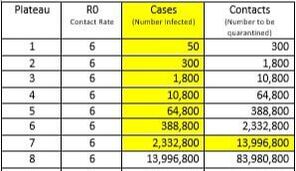www.theoxfordscientist.com
- First Duty
- ... the dry cough, a lethal hate crime
- ... open letter to Premier Danielle Smith
- Trump Guilty on all 34 Felony Counts
- shooting of PM of Slovakia
- YouTube channel, launch
- Carlson, tuckered out
- ... Chinese New Year - 2024
- ... orange jesus sprouts sixth finger
- ... Wagner Group in Africa
- ... conduct unbecoming an MP
- Alberta, burning
- ... the Trump legacy
- Eric LaMont Gregory
- Wacko in Waco
- Pence, Christian last
- ... Putin indicted
- The Egyptian Secret
- Fox fiction
- The Open Skies Treaty
- derailed in Ohio
- close your Twitter account
- ... espionage-a-lago
- Highland Park
- Canada bans handguns and assault rifles
- ... apology, only a first step
- ... world wide auto surf
- Conklin to Buffalo
- Danielle Smith and Liz Truss
- An End to War
- Globe & Mail, blatant sophistry
- conservative press, a fitting epitaph
- Uvalde, explanation time
- ... Ukraine, a crime against humanity
- Open Letter to Justin Trudeau
- Queen Elizabeth II
- Moscow Mitch
- ... illiberal roadshow descends on Edmonton
- ... don't cry for Kenney, Alberta
- ... Edmonton, on the world stage
- ... advertise in Chinese & English
- ... missing in Edmonton
- Human Rights
- Facebook, bankrupt ethically & financially
- Pelosi rejects Jordan
- ... vaccine roulette
- ... a mask in time saves nine
- 9/11 + 17
- the Gregory military doctrine
- lying Rodgers, unsportsmanlike Brady, falter
- ... best free traffic list 2021
- 34% of Covid survivors - will not fully recover -
- Trump ... doing Putin's bidding
- Coronavirus, a perfect storm
- Biden/Harris, ... America, can breathe, again
- ... in the heat of the day
- 11 September 2021
- Donald J Trump - like father, like son
- Jim Jordan will resign, inevitably
- ... raise money for your group
- Paris - Sanguinary excess, again
- Mitch McConnell is no Alexander Hamilton
- What Trump knew 28 January 2020
- None Dare Call It Murder
- use of force, part 2
- Coronavirus, the second wave
- Click & Join 2021
- Coronavirus Pandemic, Part 2
- Coronavirus Pandemic
- Terror Returns to London Bridge
- use of force, part 1
- Ohio's trio of shame
- ... how to earn Bitcoin
- Kenney: Scheer nonsense, part 2
- the dark charisma of Donald Trump
- the three stooges
- Trump's base, 24% and dwindling
- Scheer Nonsense
- getting away with murder
- World Wide Auto Surf
- Beyond a reasonable doubt
- Mueller, Redactions & Twitter
- An All Alberta Solution
- Obama Attends Raptors Game
- Call for action on cannabis convictions
- John Bolton: beware the Trojan horse
- Mandel Clarifies MMR Stance
- People First - Dai for Whitemud mp4
- Notley, Mandel or Kenney
- Dai for Whitemud. Dai for Alberta
- To refine or not to refine
- Trump under subpoena
- Mandel vs Elections Alberta
- Individual 1 - Donald J Trump
- Is Mississippi Learning?
- Stand Back & Stand By
- Flynn Seeks Delay in Sentencing
- Roadmap to Trump's Impeachment
- Michael Cohen sentenced
- Trump Obstructing Justice
- Defense Secretary Resigns
- The Ultimate Vanishing Act
- Hate Crimes are Increasing
- Trump announces Military Doctrine
- The Meeting, Trump Tower, June 9 2016
- 13 Angry White Male Senators
- Mean SOBs, Ryan & Jordan
- Trumpgate, a review of the facts
- Treason by the Dozens
- Terror on London Bridge
- Anti-Trump Ryan as Speaker, doubtful
- Haiti - shameful Red Cross 40% admin costs
- Deadly Bastille Day in Nice
- Special Powers
- Brussels - revenge attack
- Gregory's forte
- America First
- Brexit triumphs in UK referendum
- Ali
- Guns, Obama, the NRA & the Cleric
- Gorsuch & Brown v Board of Education
- The Generosity of America
- To Protect and To Serve
- Where is Alma Del Real?
- The Islamic World - a primer for policy makers
- The Lists - The Missing and Unsolved Homicides
- Michiana Murders
- Clinton
- Kings, Emperors & John Boehner
- Donnelly - the constant campaigner
- Kevin McCarthy
- Alberta Party
- Selections from The Ultimate Vanishing Act
- Malaysian Airlines Flight 370
- Ukraine - the Putin Doctrine
- Twilight
- Principles
- Bridge-gate: a closer look at Christie's staff
- Mandela
- Liangjun Wang
- Rethinking Syria
- about Chechnya
- Rethinking the War on Terror
- Tepid waters
- Linkage Blindness
- None Dare Call it Treason
- Emancipation
- Power
- Newtown - a cry for help
- Quarantine
- 11 September
- Hidden Crimes, Hidden Victims
- Cry, My Beloved Country
- Cruel Winds of October
- Doctrine
- Fed Video
- Under Seige
- Labor Day
- Destiny of America
- McEwen
- Rampage
- Threats
- GSK
- McEwen
- Condoleezza's watch
- Danger
- B R I C S
- Israel
- Huckabee
- Evidence
- Ties that Bind
- Sarajevo / Rwanda
- Violence
- Baby Safety
- MLK
- Libya
- Franklin
- Principles
- Fox 45
- America Wins Nobel Peace Prize
- Celina
- Middletown
- Arms Race
- Egypt
- Dollar
- 3 July
- $6 Trillion
- Jefferson and Adams
- 4th
- Libya
- Fening
- Abe
- Housing for Haiti
- Palin on Haiti
- ' ... an innocent man'
- Oil in the Gulf
- ... a wider regional conflict
- the demise of General McChrystal
- ... and to the republic
- BP and the Precautionary Principle
- Making Sense of Fort Hood
- Air Quality
- Un largo crepúsculo Lucha
- Israel
- Policy
- Home
- Casa
- un tambor diferente
- The Oxford Years
- Defense
- The Secret Hold
- INS will cease to exist
- ABC Toledo
- the grapes of wrath
- H1N1 Fluenza
- Tantamount to Treason
- MKL 4th speech
- Trans Dip
- Trump Rescinds DACA
- Rethinkin Syria
- Oxfam, IRC and other NPR Darlings
- Top Nine Articles for March 2015
- The Ultimate Vanishing Act
- Where is Alma Del Real?
- Alma Del Real
- 11 September
- A Measure of Philanthropic Success
- Tantamount to Treason
- South Carolina
- Double Crossed by Double Standards
- Call for photo radar cash grab inquiry
- Remembrance Day 2015
- Trudeau victory portends
- Blair Speech to Congress 2003
- Justin Trudeau, Tony Blair & Marijuana
- Trump, Harper, Ambrose & Ryan
- Saudi Arabia vs Iran
- The Islamic World ... the basics
- 2020 Presidential Candidate Releases Book
- Mississauga house explosion
- Reset: Driving Black in America
- Giuliani, shut up, stop name calling & prepare to govern
- Stop the Madness in Aleppo & Mosul
- Drain The Swamp
- Unpresidented
- Trump & the CIA, the high priest of false security
- The Hour of Maximum Danger
- Quebec, Queens U, Charleston & Trump
- Paul Ryan, Steve King, Trumpcare & Babies
- Harvey wreaks havoc
- VPN, don't surf without it
- Anju Sharma, the right choice for Edmonton-Mill Woods
- Adlandpro
- Trump's Iranian ties
- Brianna Keilar CNN - the big lie
- ... best free manual surf list 2021
- the Gregory military doctrine
- theOxfordscientist.com now on Tik Tok
- Chopin
- in the Course of human events
- 37 countries ban felon Trump
- un Plat qui se Mange Froid
- Trump shot at rally by 20-year-old
Joe Biden - Kamala Harris
President & Vice President
of the United State of America
President & Vice President
of the United State of America
... America, can breathe, again
I trust the introductory email to this communication was met with sufficient interest to occasion your personal perusal of this material.
... a mask in time, saves nine
The importance of wearing a mask from a clinical perspective, equates the severity of coronavirus symptoms to the number of viral particles inhaled, and whether the infection was the result of a singular or multiple exposures.
After a deluge of requests, to state whether the preceding statement was accurate or otherwise, the CDC-USA, in a written statement issued on the 22 of October 2020, not surprisingly, confirmed its accuracy, while at the same time substituting the word cumulative for this author's suggested terminology, multiple exposures. We will return to the importance of terminology in the section on waves vis-à-vis spikes and surges.
There are four principal criteria to be applied to the evaluation of the efficacy and effectiveness of a face mask, especially a mask to be used to contain the spread of the SARS-CoV-2 virus i.e., breathability, fit, pore size and whether the material from which the mask is made is hydrophobic (moisture repellent), or hydrophilic (moisture attracting).
After stating the obvious, one is confronted often with the phrase that 'it goes without saying' or other words which convey the same meaning, as is the case with our first criteria of evaluation. The first criteria concerns, breathability, that is, the wearer of the mask must be able to breathe properly through the mask. Otherwise, its use would be counterproductive, in the extreme.
The second criteria, fit, encompasses both the ability of the mask to cover both the nose and mouth, while at the same time, the mask must prevent the aerosol containing the airborne viral particles from entering the nose and mouth area through the fabric of the mask, as well as, from around the perimeter of the mask. In this specific regard, fit, the respirator might prove the preferred face-mask device.
Pore size, the third principal criteria, takes into consideration the size of the virus-laden aerosol particles, otherwise known as droplets and spray, from passing through the fabric of the mask.
A N95 grade mask, for example, is rated by different observers as having the ability to screen between 85 to 95% of air-borne particles smaller than 300 nanometres. The nanometre is a unit of length in the metric system, equal to one billionth of a metre, and is expressed in scientific notation as 1×10⁻⁹ metre.
At the same time, as we have suggested above, the wearer must be able to breathe normally, that is, without restricting the wearer's ability to take in a sufficient amount of air to sustain life.
The size of the aerosol, droplets and spray, emitted into the air by a coronavirus disease carrier through coughs, sneezes, talking and breathing, varies between 65 to 125 nm. Therefore, a mask must be able to prevent particles of this size from flowing through it to be an effective barrier.
The aerosol, droplets and spray, that a carrier emits into the air is moist, which necessitates that the material from which the mask is made should be hydrophobic, moisture repelling.
If, the material is hydrophilic, moisture attracting, the pores of the mask material will trap virus laden particles, and make it possible for the wearer to draw virus through the mask as the pores become increasingly saturated, clogged, with moist virus-laden particles.
There are mask-like products on the market which suggest that they can also be used as cooling devices by soaking them in water prior to use.
At the same time, recent advances in mask technology should be incorporated into future containment strategies (1).
There simply are no national evidence-based standards for face masks. And yet, the face mask remains a heralded pre-vaccine containment measure along with social distancing, the ubiquitous quarantine, and sheltering-in-place.
1. A Flexible Nanoporous Template for the Design and Development of Reusable Anti-COVID-19 Hydrophobic Face Masks. ACS Nano. 20 May 2020. DOI: 10.1021/acsnano.0c03976
Best regards,
E LaMont Gregory MSc (Oxford)
E LaMont Gregory MSc (Oxford)
___ ___ ___
... Humpty Trumpty never built the wall,
And yet, Humpty Trumpty still had a great fall,
And all the would-be-king’s nationalistic force,
Proved no match for democratic recourse.
And so the saga of Donald J Trump will be told,
In the annals of the country he so cheaply sold,
And they follow him blindly, shouting, 'lock her up',
While this great country they so shamelessly disrupt.
In a din, they chanted, make America great again,
In reality, America was never actually on the mend,
An election returned America to a sense of sober glee,
And with his passport secured, he cannot flee.
... Humpty Trumpty never built the wall,
And yet, Humpty Trumpty still had a great fall,
And all the would-be-king’s nationalistic force,
Proved no match for democratic recourse.
And so the saga of Donald J Trump will be told,
In the annals of the country he so cheaply sold,
And they follow him blindly, shouting, 'lock her up',
While this great country they so shamelessly disrupt.
In a din, they chanted, make America great again,
In reality, America was never actually on the mend,
An election returned America to a sense of sober glee,
And with his passport secured, he cannot flee.
The table above should be understood as follows. Consider the 50 cases of infection identified at the Plateau 1 level. It has been established that each infected person can infect, on average, six (6+) other persons i.e., R0 (R-zero factor of 6+).
The R-zero factor of six (6) was obtained from calculations made in the early days of the novel coronavirus outbreak, when researchers around the globe still had access to data from several southeast Asian countrie, including welth of Dt from Hubei
And, this is the crux of the matter. Once you have 50 infections, and you do not want to progress to Plateau 2, 300 cases, you must track the initial 300 contacts from Plateau 1, and quarantine them immediately subject to testing, that is, contact justifies being placed in quarantine, and testing alone can release one from being quarantined.
One individual in New Rochelle, New York, confirmed to have been infected with the novel coronavirus, had close contact with 50 other persons through his business and through attendance at religious services. Each of his contacts had close contact with, on average, 6 other persons, 6 x 50 = 300. Each of these contacts, in turn, had contact with 6 others, and by this juncture, therefore, there were some, 6 x 300 = 1800, persons possibly infected with the virus in that area.
Governor Andrew Cuomo of New York then ordered National Guard troops into New Rochelle. And, as discussed in the previous communication - https://www.theoxfordscientist.com/coronavirus-the-second-wave.html - this move was welcomed literally around the globe. From Milan, where health workers found it difficult to awaken Italian authorities to the true nature and scope of the coronavirus outbreak, to Iceland where an American company operating in Iceland helped the identification and tracing of some 7800 people who had had contact with the first 600 cases on that island, by providing the test kits for the coronavirus.
The sense of anticipation associated with the Cuomo troop call up for those in Milan, who desperately wished to implement an identification and tracing program, and those in Reykjavik, Seoul, Shanghai and Taipei who implemented identification and tracing programs, although not emanating from Washington, was that the Americans were going to be the example of how a program of identification and tracing could be implemented in a liberal democracy, and take the US off the unrestrained exponential coronavirus growth curve.
But inexplicably, rather than deploy the troops to the task of augmenting the ability of the local health departments to carry out a rigorous tracing program to locate all those who may have been infected, as successfully demonstrated in Iceland and elsewhere, the troops became glorified traffic watchers and played no active part in the infectious disease control process.
The sense of anticipation turned to palpable dismay.
At 11am EST, on the morning of the 27th of April 2020, the Canada.ca website records 14,856 persons infected with the coronavirus in Ontario. That number, if the present means of infectious disease mitigation, which relies primarily on hygiene and social distancing, remains the primary means of infectious disease control, that number having surpassed the 10,800 plateau, will rise to the next plateau of 64,800 persons infected with coronavirus in Ontario.
Just as, once the total number of cases in the United States exceeded 388,800, it became inevitable that that number would rise to 2,332,800. It should be noted that in the last 30 days, total US cases have risen from approximately 388,800 to over one million cases of infection with the coronavirus.
In Alberta, where the number of known infections on the 28th of April stood at 4,850, again, it is inevitable, barring the immediate implementation of a case identification and contact tracing effort involving some 29,100 contacts with those known to be infected, Alberta will reach the next plateau of 10,800 infections in the near future.
Having witnessed hundreds upon hundreds die in long-term care facilities, when a stringent protocol of case identification and screening for all patients and all caregivers was suggested and ignored by both our professional health authorities and political leaders, but remains the most prudent means to curtail the spread of coronavirus in long-term care facilities, it is difficult to understand what will trigger the rigorous implementation of screening for the coronavirus to protect those in long-term care.
The R-zero factor of six (6) was obtained from calculations made in the early days of the novel coronavirus outbreak, when researchers around the globe still had access to data from several southeast Asian countrie, including welth of Dt from Hubei
And, this is the crux of the matter. Once you have 50 infections, and you do not want to progress to Plateau 2, 300 cases, you must track the initial 300 contacts from Plateau 1, and quarantine them immediately subject to testing, that is, contact justifies being placed in quarantine, and testing alone can release one from being quarantined.
One individual in New Rochelle, New York, confirmed to have been infected with the novel coronavirus, had close contact with 50 other persons through his business and through attendance at religious services. Each of his contacts had close contact with, on average, 6 other persons, 6 x 50 = 300. Each of these contacts, in turn, had contact with 6 others, and by this juncture, therefore, there were some, 6 x 300 = 1800, persons possibly infected with the virus in that area.
Governor Andrew Cuomo of New York then ordered National Guard troops into New Rochelle. And, as discussed in the previous communication - https://www.theoxfordscientist.com/coronavirus-the-second-wave.html - this move was welcomed literally around the globe. From Milan, where health workers found it difficult to awaken Italian authorities to the true nature and scope of the coronavirus outbreak, to Iceland where an American company operating in Iceland helped the identification and tracing of some 7800 people who had had contact with the first 600 cases on that island, by providing the test kits for the coronavirus.
The sense of anticipation associated with the Cuomo troop call up for those in Milan, who desperately wished to implement an identification and tracing program, and those in Reykjavik, Seoul, Shanghai and Taipei who implemented identification and tracing programs, although not emanating from Washington, was that the Americans were going to be the example of how a program of identification and tracing could be implemented in a liberal democracy, and take the US off the unrestrained exponential coronavirus growth curve.
But inexplicably, rather than deploy the troops to the task of augmenting the ability of the local health departments to carry out a rigorous tracing program to locate all those who may have been infected, as successfully demonstrated in Iceland and elsewhere, the troops became glorified traffic watchers and played no active part in the infectious disease control process.
The sense of anticipation turned to palpable dismay.
At 11am EST, on the morning of the 27th of April 2020, the Canada.ca website records 14,856 persons infected with the coronavirus in Ontario. That number, if the present means of infectious disease mitigation, which relies primarily on hygiene and social distancing, remains the primary means of infectious disease control, that number having surpassed the 10,800 plateau, will rise to the next plateau of 64,800 persons infected with coronavirus in Ontario.
Just as, once the total number of cases in the United States exceeded 388,800, it became inevitable that that number would rise to 2,332,800. It should be noted that in the last 30 days, total US cases have risen from approximately 388,800 to over one million cases of infection with the coronavirus.
In Alberta, where the number of known infections on the 28th of April stood at 4,850, again, it is inevitable, barring the immediate implementation of a case identification and contact tracing effort involving some 29,100 contacts with those known to be infected, Alberta will reach the next plateau of 10,800 infections in the near future.
Having witnessed hundreds upon hundreds die in long-term care facilities, when a stringent protocol of case identification and screening for all patients and all caregivers was suggested and ignored by both our professional health authorities and political leaders, but remains the most prudent means to curtail the spread of coronavirus in long-term care facilities, it is difficult to understand what will trigger the rigorous implementation of screening for the coronavirus to protect those in long-term care.




